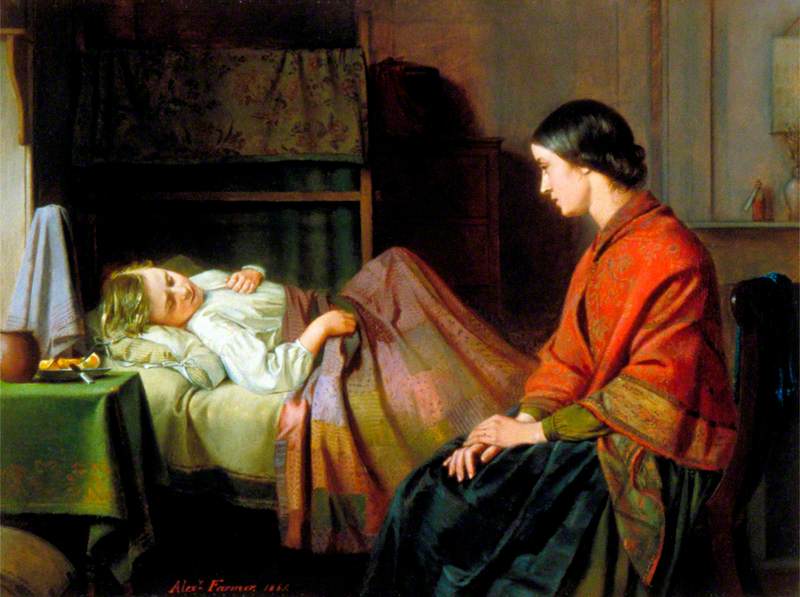
Wednesday
Amy Davidson Sorkin has a lovely New Yorker article on how Dickens and Charlotte Bronte characters handle epidemics. The classics she mentions reinforce the imperative to “settle in place” at such moments.
Sorkin sees Esther Summerson in Bleak House as “one of the great heroines of literature, in part because she understands the vital importance of social distancing and isolation, even when it is hard.” Sorkin is thinking of the episode where, while tending a smallpox sufferer, Esther hears housemate and best friend Ada Clair approaching:
Esther doesn’t hesitate: “I hurried to the door of communication between my room and our pretty sitting-room, and locked it. Just in time, for she tapped at it while my hand was yet upon the key.”
When Esther herself contracts the illness, she insists on the same distancing:
Before Esther slips into delirium, she makes Charley, whom she has nursed and who by then has recovered enough to nurse her, promise not to let anyone in—especially not Ada. “When she knows I am ill, she will try to make her way into the room,” Esther says. “Keep her out, Charley, if you love me truly, to the last!” Charley, despite her youth, does the job, which is a terrible one:
I had heard my Ada crying at the door, day and night; I had heard her calling to me that I was cruel and did not love her; I had heard her praying and imploring me to be let in to nurse and comfort me, and to leave my bedside no more. . . . Charley had been true to me in that time of need, and with her little hand and her great heart had kept the door fast.
Jane Eyre fans will remember the typhus that rampages through Lowood school, where “semi-starvation and neglected colds had predisposed most of the pupils to receive infection; forty-five of the eighty girls lay ill at one time.”
When she goes to visit her friend Helen Burns, who has tuberculosis, not typhus, Jane instinctively knows that she must steer clear of the fever room, with its “odour of camphor and burnt vinegar.”
Sorkin notes that, as horrendous as the tragedy is, something positive emerges from it and wonders if that will be our case as well:
The typhus runs its course and disappears, “but not till its virulence and the number of its victims had drawn public attention on the school. Inquiry was made into the origin of the scourge, and by degree various facts came out which excited public indignation in a high degree.” There was a new building, new regulations, better food, a better system. “The school, thus improved, became in time a truly useful and noble institution.” Let the same be said of many of our institutions, once we are through this.
Sorkin pulls together these literary images in her conclusion, which includes a reminder that social distancing is essential:
In some ways, with covid-19, we are as vulnerable as the Victorians were—given the novelty of the virus, our lack of immunity, the inequalities that make its depredations worse. We are all like a child in a dark hallway. But in many other respects, of course, we are lucky: covid-19 has not proved as deadly as smallpox (which has been eradicated) or typhus. We know how diseases spread. Doctors around the world are working on vaccines and treatments, and there is every faith that they’ll find them. Until then, we can do what we have long known how to do. Keep on different sides of the door—the Adas and Esthers among us can FaceTime or Zoom—and do everything humanly possible to lighten the load on hospitals and medical professionals. Remember that most of us can walk past the fever room. They have to go inside.
Looking over deathbed scenes in 19th century literature reminds us what a gift medical science has been. Illnesses that once swept regularly through our homes have been contained (although anti-Vaxxers, bolstered by unscrupulous politicians like Trump, have sought to undo some of the progress). Sickness is far less prominent in contemporary novels.
For a contrast, think of Beth in Little Women, who dies of scarlet fever; Mary’s parents in The Secret Garden, who die of of cholera; Tiny Tim, who will die of rickets without Scrooge’s intervention; Bazarov in Turgenev’s Fathers and Sons, who dies of typhoid fever; and Bessy Higgins in Elizabeth Gaskell’s North and South, who dies of tuberculosis. Tertius Lydgate, the doctor in Middlemarch, is ahead of his time in wanting to bring sanitation to hospitals.
We currently have a president who doesn’t read and doesn’t want to hear the bad news he’s getting from medical experts. We’re now learning that the United States is well on its way to becoming the epicenter of COVID-19, and it will remain so if states listen to Trump’s calls to open up the economy prematurely.
A liberal education gives one a sense of history, without which we improvise from day to day. We are getting pounded by ignorance.